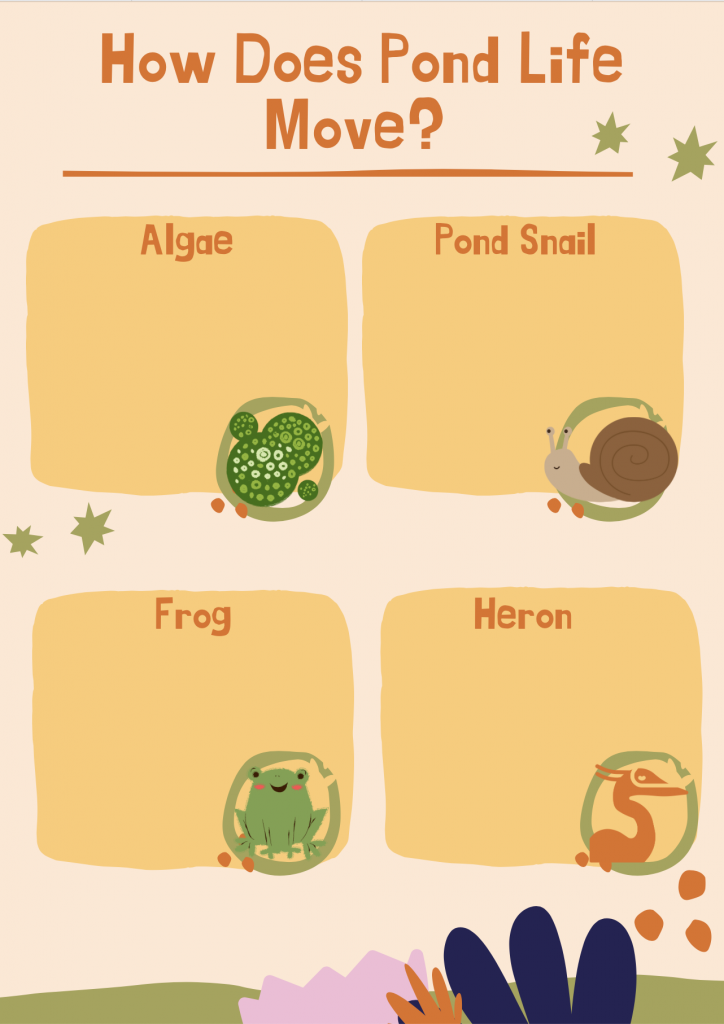By Layla Sastry
Image © moodboard/ Adobe Stock
A note from the editor: “Readers, use these examples and add additional animals and videos for the children in your care to describe and dance to the animals’ movements.” -WGS
The following is an exercise that can be used with younger and older children to help them connect to and know life in and around ponds.
Warm Up (5 minutes)
Note: Use the attached graphic to record the three to five verbs/action words students generate to describe the movement of each of the following species.
- Graphic to record verbs/action words:

- For inspiration, see the provided link to a verb/action word list: https://thedramateacher.com/words-used-to-describe-movement-in-performance/
Observing the algae (8 minutes)
i. Video of Algae:
Ask students to come up with three to five verbs/action words to describe the algae’s movement and shape. Below are some questions to prompt word generation.
- What are some words you can think of to describe the shape of the algae or the way it moves?
- Does it move quickly or slowly?
Once you have recorded their three to five words, invite them to stand. Go through each of the words and have the students explore their movement responses to these words.
- Ask questions and raise ideas to prompt new and creative ways of doing the movement
- For example: “how might this movement be different if we did it backwards or sideways?”
- For example: “how might this movement be different if we did it backwards or sideways?”
Observing the pond snails (8 minutes)
- Video of pond snails (start video at 1:51)
Ask students to come up with three to five verbs/action words to describe the snail’s movement. Below are some questions to prompt word generation.
- How does the snail’s body move against the water?
- How can we describe the shape of the snail’s shell?
Once you have recorded the students’ three to five words, invite them to stand. Go through each of the words and have the students explore their movement responses to these words.
- Ask questions and raise ideas to prompt new and creative ways of doing the movement
- For example: “how can we spiral our bodies like the snail’s shell?” “Can we make a spiral shape with our spine?” “Can we make a spiral shape with our fingers?”
Observing the frogs (8 minutes)
Frogs jumping
Frog swimming
Ask youth to come up with three to five words to describe how the frog swims and jumps. Below are some questions to prompt word generation.
- How can we describe the way the frog’s legs move?
- What shapes do their bodies make as they swim through the water?
- How can we describe the way they jump and fly through the air?
Once you have recorded the students’ three to five words, invite them to stand. Go through each of the words and have the students explore their movement responses to these words.
- Ask questions and raise ideas to prompt new and creative ways of doing the movement
- For example: “What other directions can we jump” (forward, backwards, sideways)? “What does it feel like for the legs to crunch up and then extend?”
Observing the heron (8 minutes)
Video of heron:
Ask students to come up with three to five words to describe the heron’s body and how the heron flies. Below are some questions to prompt word generation.
- How would you describe the shapes of the heron’s body?
- What are some verbs/action words to describe the heron in flight?
Once you have recorded the students’ three to five words, invite them to stand. Go through each of the words and have the students explore their movement responses to these words.
- Ask questions and raise ideas to prompt new and creative ways of doing the movement
- For example: “can you fly backwards?” “How can we arch our arms to mimic the shape of the heron’s neck?”



very good